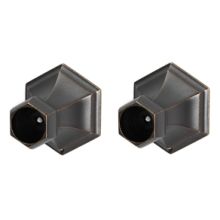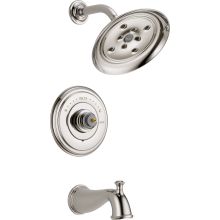4 DIY Cleaning Tips to Save That Shower Curtain!
A little regular shower curtain maintenance can lengthen the lifespan of your favorite shower curtain.

Many people buy new shower curtains or liners when the old ones look dirty, but there are things you can do to clean your shower curtain and make it look brand new. By cleaning rather than replacing, you can save money and continue using the liner that matches your current bathroom style. There are many reasons why your curtain may start to look filthy but there are just as many ways to keep them from staying that way.
What Is That Stuff, Anyway?
Often, drapes appear murky and gross due to soap scum. This white filmy layer of grime is a mixture of soap buildup and mineral deposits. Residue can be left on the bottom of your bathtub floor as well as your shower curtains and can diminish the appearance of any of your bathroom fixtures.
Mildew can be a problem due to the dampness of the shower and shower curtain. This type of bacteria is generally a white/gray color and can stain fabric. It can also leave a strong, musty odor in your bathroom.
Hard water stains often remain on your shower curtain, leaving it clouded and discolored. These dirty spots are created by calcium, limestone, and magnesium that are in your water supply. Water that contains large amounts of these minerals creates more hard water stains. The combination of these problems can create a dull and dirty shower curtain.
There are many methods you can use to easily remove these problems without having to buy a new curtain, but you’ll find some ways that work better than others, depending on the material of your shower drapes.
1. The Baking Soda Method for Plastic Curtains
Soap scum isn’t too hard to remove, especially on plastic. After detaching the curtain from the shower rod, place the plastic on the ground or on a table. With the help of some baking soda, a microfiber rag, and a bit of elbow grease, you can easily scrub away any grime that you see. Simply wet the cloth and sprinkle on baking soda, then rub away the stains and mineral deposits.
Rinse with warm water and revisit any areas on the plastic that are still dirty. Once you are finished, replace your sparkling clean shower curtain and enjoy the view. Afterward, your bathroom may smell fresher because baking soda is a natural deodorizer.
2. The Washing Machine Method for Plastic Curtains
If you aren’t excited about taking the time to scrub your entire plastic curtain, feel free to use the washing machine method. Gently set your curtain in the washer with a few towels (to prevent the plastic from wrinkling,) and add either vinegar, baking soda, or a soft laundry detergent.
However, don’t combine these cleaning products without doing research beforehand. Mixing certain cleaning fluids, like vinegar and baking soda, can create dangerous chemical reactions.
After your washing machine has completed the rinse cycle, reattach the shower curtain to the rod and rinse it down with the shower spray. Most hard water stains and soap scum will be eliminated, leaving you with a clean, shiny plastic curtain.
3. The Bucket Method for Cloth Liners
Cloth liners can be challenging to clean. When a bright white fabric turns yellow or brown, it’s definitely time to clean your shower drapes.
Find a bowl or bucket that is large enough to fit your shower liner and add a large scoop of powdered oxygen bleach. Add a gallon of hot water and let your shower curtain soak for several hours. Drain the water out and determine whether or not the stains have fully disappeared. If they haven’t, soak them a second time.
Once you are satisfied, wash your liner in the washing machine by following the instructions on the curtain tag. When it’s run through the wash, hang it up to dry, and the liner will look a lot cleaner.
4. The Borax and Lemon Juice Method for Cloth Liners
If you spot only a few stains, use a paste of borax and lemon juice to clean the liner. Rub the paste into the hard water spots or stains and let the curtain sit overnight. Throw it in the washing machine to wash out the paste and grime. If there are any mildew spots remaining, repeat the cleaning process and wash once more.
Preventative Measures
Keep in mind that there are plenty of ways to prevent soap scum and hard water spots from causing problems. To maintain the cleanliness of your plastic curtain, consider pretreating it with vinegar. After purchasing your curtain, rinse it in your washing machine with white distilled vinegar. However, keep an eye on the temperature setting on the washer so that you don’t end up melting your brand-new curtain. Hang the plastic on the shower rod to dry.
If you are worried about mold or mildew, make sure to air out your shower curtain between each shower. This can prevent damp drapes from becoming a problem.
If mildew is still an issue, consider alternating shower curtains every month. Simply remove one and replace it with a fresh bathroom curtain. Wash the other drape with one of the methods above and let it hang to dry. Once it is fully dry, put it away until you switch curtains.
When to Clean Your Bathroom Curtains
Due to the frequency of your baths and showers, you may have to clean the drapes more often than you think. The ideal goal, for optimum bathroom cleanliness, is to clean and dry shower curtains every month. However, if you notice that your shower curtains appear to stay cleaner for longer periods of time, feel free to do it only a few times a year.
Hard water stains, soap scum, and mildew are the leading factors of dirty, stained curtains, but taking preventative measures as well as cleaning your drapes frequently can help you eliminate any problems. Many of these methods use ingredients that can be found in your pantry or cleaning supply. Although cleaning shower curtains may seem like a hassle, it is worth it to have clean, spotless drapes to beautify and enhance your bathroom.


